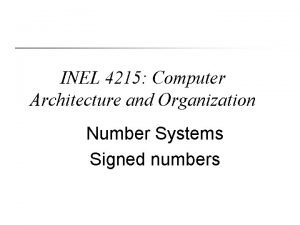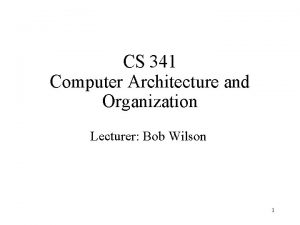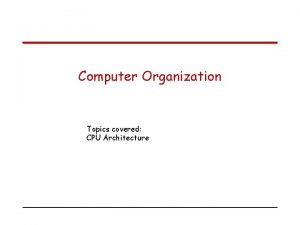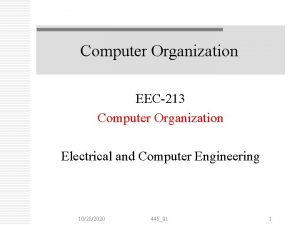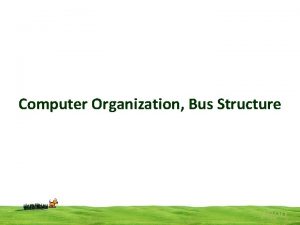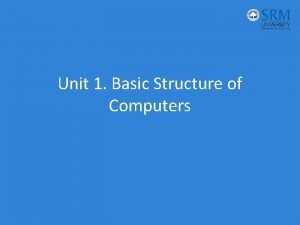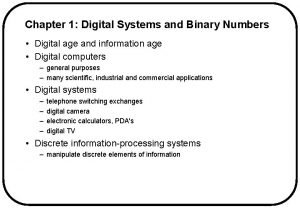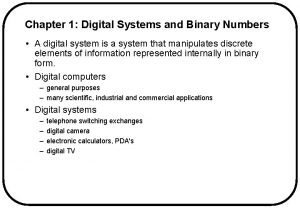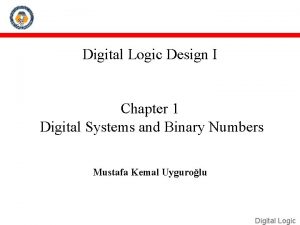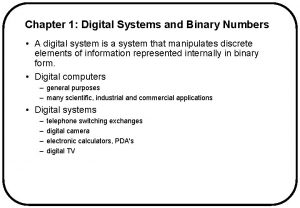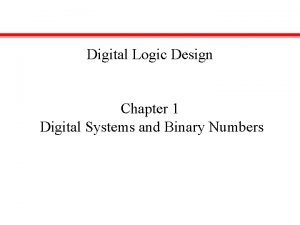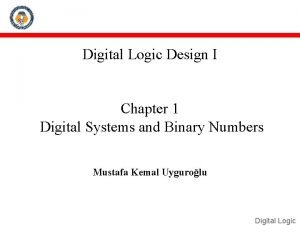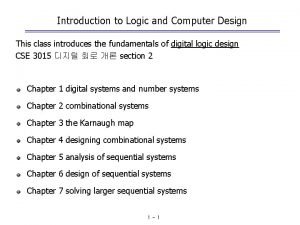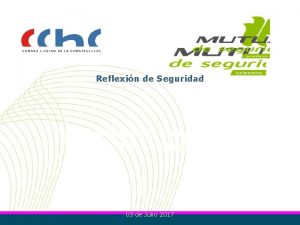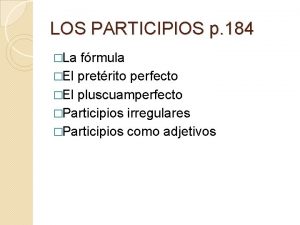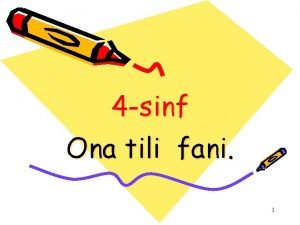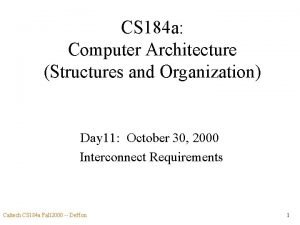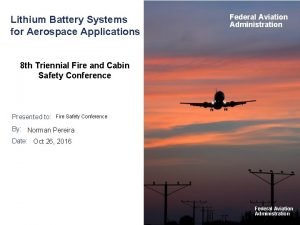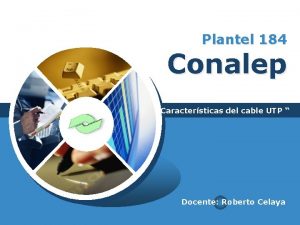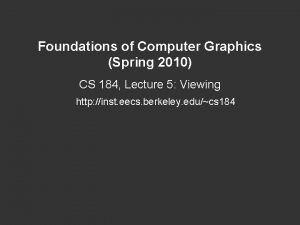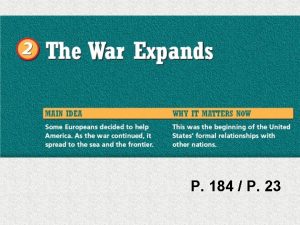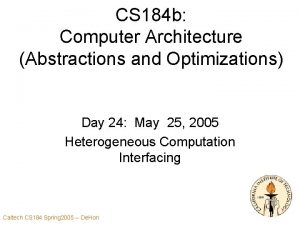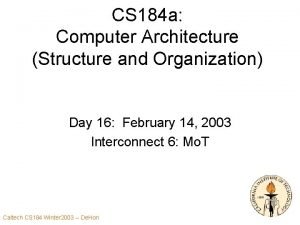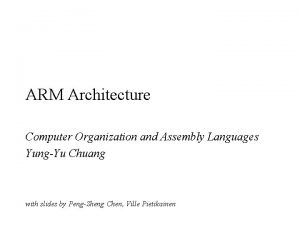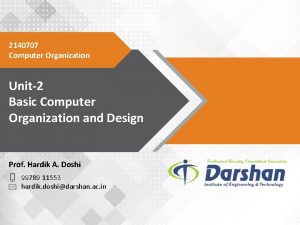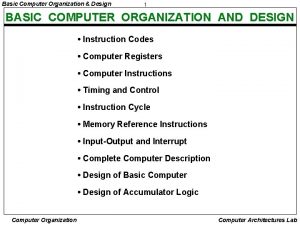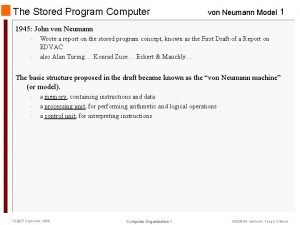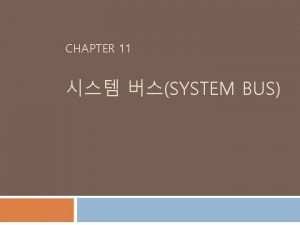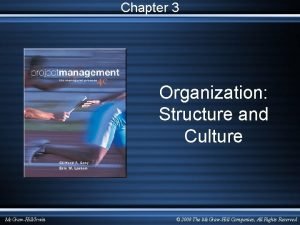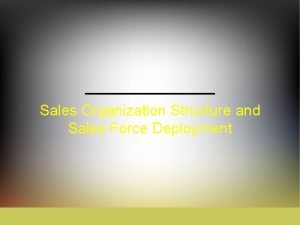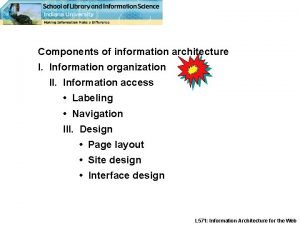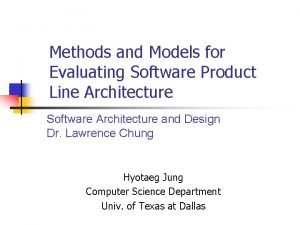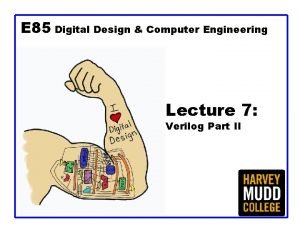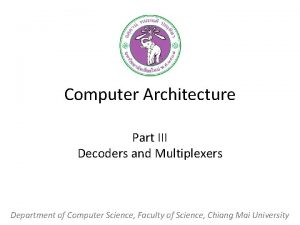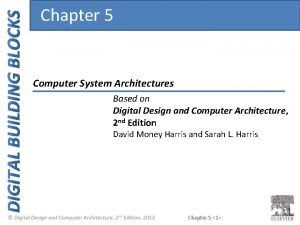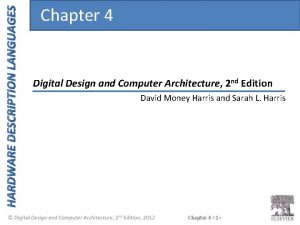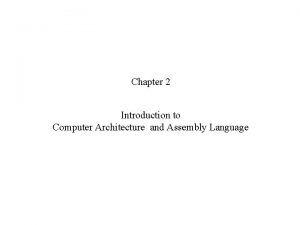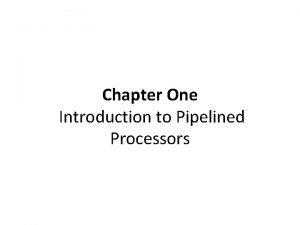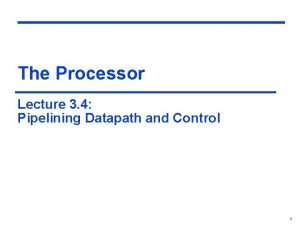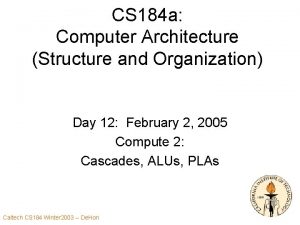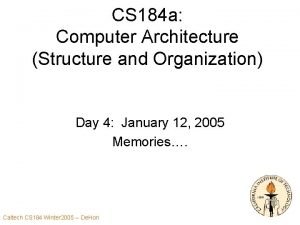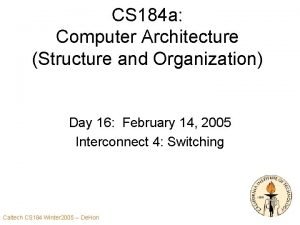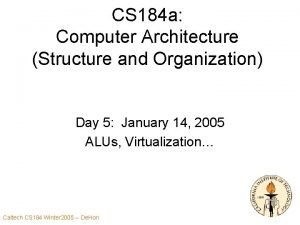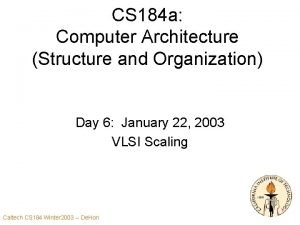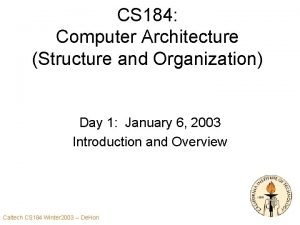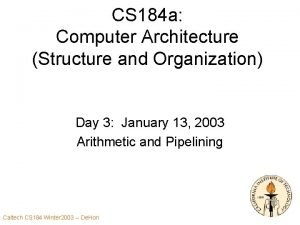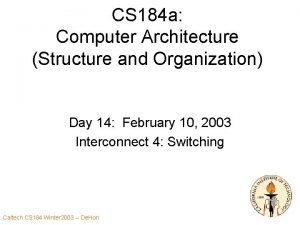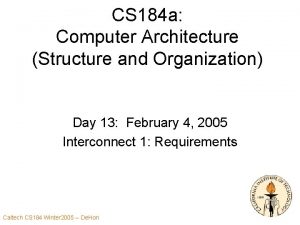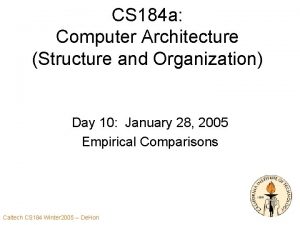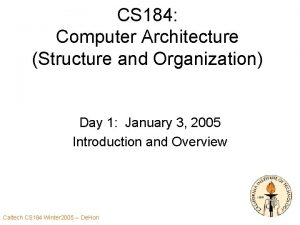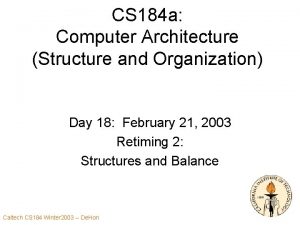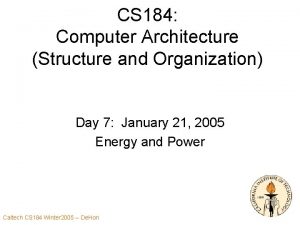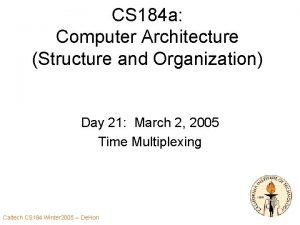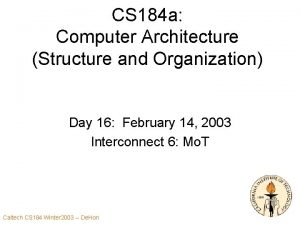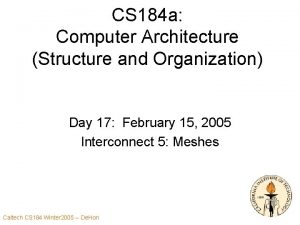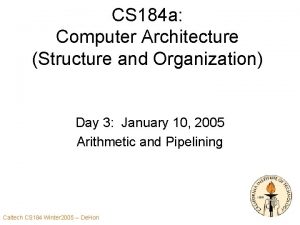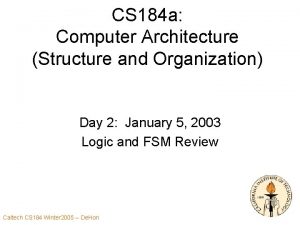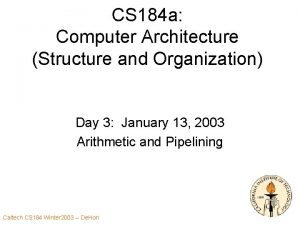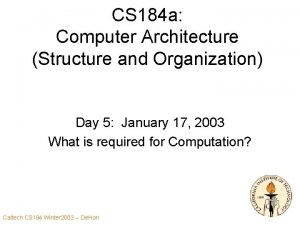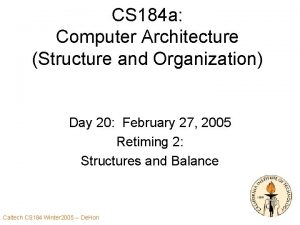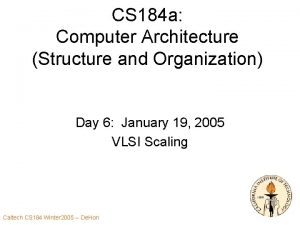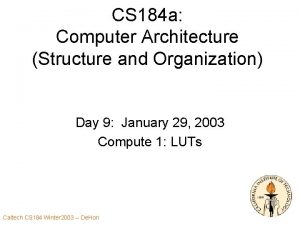CS 184 a Computer Architecture Structure and Organization


































































![Big Ideas [MSB Ideas] • Can implement any Boolean function in gates • Can Big Ideas [MSB Ideas] • Can implement any Boolean function in gates • Can](https://slidetodoc.com/presentation_image_h2/ddaaa813d5a3bce88841275a8268362d/image-67.jpg)
![Big Ideas [MSB-1 Ideas] • Canonical representation for combinational logic • Transformation – don’t Big Ideas [MSB-1 Ideas] • Canonical representation for combinational logic • Transformation – don’t](https://slidetodoc.com/presentation_image_h2/ddaaa813d5a3bce88841275a8268362d/image-68.jpg)
- Slides: 68

CS 184 a: Computer Architecture (Structure and Organization) Day 2: January 8, 2003 Logic and FSM Review Caltech CS 184 Winter 2003 -- De. Hon

Last Time • Computational Design as an Engineering Discipline • Importance of Costs Caltech CS 184 Winter 2003 -- De. Hon

Today • Simple abstract computing building blocks – gates, boolean logic – registers, RTL • Logic in Gates – optimization – properties – costs • Sequential Logic Caltech CS 184 Winter 2003 -- De. Hon

Reading Comment • Web page indicates what’s required/supplemental • Handed out 3 things on Monday – First two (From P&H) • Just if you want something to review/reference for boolean logic / arithmetic / FSMs – Third (From W&H) • Suggested reading Caltech CS 184 Winter 2003 -- De. Hon

Stateless Functions/Comb. Logic • Compute some “function” – f(i 0, i 1, …in) o 0, o 1, …om • Each unique input vector – implies a particular, deterministic, output vector Caltech CS 184 Winter 2003 -- De. Hon

Specification in Boolean logic – o=a+b – o=/(a*b) – o=a*/b + b – o=a*b+b*c+d*e+/b*f + f*/a+abcdef – o=(a+b)(/b+c)+/b*/c Caltech CS 184 Winter 2003 -- De. Hon

Implementation in Gates • Gate: small Boolean function • Goal: assemble gates to cover our desired Boolean function • Collection of gates should implement same function • I. e. collection of gates and Boolean function should have same Truth Table Caltech CS 184 Winter 2003 -- De. Hon

Covering with Gates – o=(a+/b)(b+c)+/b*/c Caltech CS 184 Winter 2003 -- De. Hon

Equivalence • There is a canonical specification for a Boolean function – it’s Truth Table • Two expressions, gate netlists, a gate netlist and an expression -- are the same iff. – They have the same truth table Caltech CS 184 Winter 2003 -- De. Hon

Truth Table • o=/a*/b*c+/a*b*/c+a*/b*c a b c o 0 0 0 1 1 0 1 0 1 0 0 0 1 1 1 1 0 Caltech CS 184 Winter 2003 -- De. Hon

How many Gates? • o=/a*/b*c+/a*b*/c+a*/b*c a b c o 0 0 0 1 1 0 1 0 1 0 0 0 1 1 1 1 0 Caltech CS 184 Winter 2003 -- De. Hon

How many gates? – o=(a+/b)(b+c)+/b*/c a 0 0 1 1 b 0 0 1 1 c 0 1 0 1 o 1 1 0 0 1 1 Caltech CS 184 Winter 2003 -- De. Hon

Engineering Goal • Minimize resources – area, gates • Exploit structure of logic • “An Engineer can do for a dime what everyone else can do for a dollar. ” Caltech CS 184 Winter 2003 -- De. Hon

Sum of Products • o=/a*/b*c+/a*b*/c+a*/b*c • o=(a+b)(/b+/c) – a*b+a*/c+b*/c • o=(a+/b)(b+c)+/b*/c – a*b+a*c+/b*c +/b*/c Caltech CS 184 Winter 2003 -- De. Hon

Minimum Sum of Products • o=/a*/b*c+/a*b*/c+a*/b*c + b*/c Caltech CS 184 Winter 2003 -- De. Hon

Minimum Sum of Products • o=(a+b)(/b+/c) a*/b+a*/c+b*/c a*/b + b*/c Caltech CS 184 Winter 2003 -- De. Hon ab 00 01 11 10 0 0 1 1 1 c 1 0 0 0 1

Redundant Terms • o=(a+b)(/b+/c) – a*/b+a*/c+b*/c – a*/b + b*/c Caltech CS 184 Winter 2003 -- De. Hon ab 00 01 11 10 0 0 1 1 1 c 1 0 0 0 1

There is a Minimum Area Implementation • o=(a+b)(/b+/c) – a*/b+a*/c+b*/c – a*/b + b*/c Caltech CS 184 Winter 2003 -- De. Hon ab 00 01 11 10 0 0 1 1 1 c 1 0 0 0 1

There is a Minimum Area Implementation • Consider all combinations of less gates: – any smaller with same truth table? – There must be a smallest one. Caltech CS 184 Winter 2003 -- De. Hon

Not Always MSP • o=(a+b)(c+d) – a*b+a*c+b*c +b*d 3 2 -input gates 7 2 -input gates • Product of Sums smaller… Caltech CS 184 Winter 2003 -- De. Hon

Minimize Area • Area minimizing solutions depends on the technology cost structure • Consider: – I 1: ((a*b) + (c*d))*e*f – I 2: ((a*b*e*f)+(c*d*e*f)) • Area: – I 1: 2*A(and 2)+1*A(or 2)+1*A(and 3) – I 2: 2*A(and 4)+1*A(or 2) Caltech CS 184 Winter 2003 -- De. Hon

Minimize Area – I 1: ((a*b) + (c*d))*e*f – I 2: ((a*b*e*f)+(c*d*e*f)) • Area: – I 1: 2*A(and 2)+1*A(or 2)+1*A(and 3) – I 2: 2*A(and 4)+1*A(or 2) • all gates take unit area: q A(l 2)=3 < A(l 1)=4 • gate size proportional to number of inputs: q A(I 1)=2*2+2+3=9 < A(I 2)=2*4+2=10 Caltech CS 184 Winter 2003 -- De. Hon

Best Solution Depends on Costs • This is a simple instance of the general point • …When technology costs change, the optimal solution changes. • In this case, we can develop an automated decision procedure which takes the costs as a parameter. Caltech CS 184 Winter 2003 -- De. Hon

Don’t Cares • Sometimes will have incompletely specified functions: a b c o 0 0 0 1 1 0 1 0 1 1 x 1 0 0 x 1 0 1 1 0 0 1 -- 1 De. Hon 1 0 Caltech CS 184 Winter 2003

Don’t Cares • Will want to pick don’t care values to minimize implementation costs: a b c o 0 0 0 1 1 0 1 0 1 0 1 1 x 0 1 1 0 0 x 1 0 0 0 1 0 1 0 1 1 0 0 1 -- 1 De. Hon 1 0 1 1 1 0 Caltech CS 184 Winter 2003

NP-hard in General • Logic Optimization – Two Level Minimization – Covering w/ reconvergent fanout • Are NP-hard in general – …but that’s not to say it’s not viable to find an optimal solution. • Cover how to attack in CS 137 – can point you at rich literature – can find software to do it for you Caltech CS 184 Winter 2003 -- De. Hon

Delay in Gates • Simple model: – each gate contributes a fixed delay for passing through it – can be different delay for each gate type – e. g. • • inv = 50 ps nand 2=100 ps nand 3=120 ps and 2=130 ps Caltech CS 184 Winter 2003 -- De. Hon

Path Delay • Simple Model: Delay along path is the sum of the delays of the gates in the path Path Delay = Delay(And 3 i 2)+Delay(Or 2) Caltech CS 184 Winter 2003 -- De. Hon

Critical Path • Path lengths in circuit may differ • Worst-case performance of circuit determined by the longest path • Longest path designated Critical Path Caltech CS 184 Winter 2003 -- De. Hon

Multiple Paths Path Delay = Delay(Or 2 i 1)+Delay(And 2)+Delay(Or 2) Path Delay = Delay(And 3 i 2)+Delay(Or 2) Caltech CS 184 Winter 2003 -- De. Hon

Critical Path = Longest Path Delay = 3 Path Delay = 2 Caltech CS 184 Winter 2003 -- De. Hon

Critical Path • There is always a set of critical paths – set such that the path length of the members is at least as long as any other path length • May be many such paths Caltech CS 184 Winter 2003 -- De. Hon

Minimum Delay • There is a minimum delay for a given function and technology cost. • Like area: – consider all circuits of delay 1, 2, …. – Work from 0 time (minimum gate delay) up – stop when find a function which implements the desired logic function – by construction no smaller delay implements function Caltech CS 184 Winter 2003 -- De. Hon

Delay also depend on Costs • Consider again: – I 1: ((a*b) + (c*d))*e*f – I 2: ((a*b*e*f)+(c*d*e*f)) • Delay: – I 1: D(and 2)+D(or 2)+D(and 3) – I 2: D(and 4)+D(or 2) Caltech CS 184 Winter 2003 -- De. Hon

Delay also depend on Costs • Delay: – I 1: D(and 2)+D(or 2)+D(and 3) – I 2: D(and 4)+D(or 2) • D(and 2)=130 ps, D(and 3)=150 ps, D(and 4)=170 ps q. D(I 2)=(170+D(or 2))<D(I 1)=(130+150+D(or 2)) • D(and 2)=90 ps, D(and 3)=100 ps, D(and 4)=200 ps q. D(I 2)=(200+D(or 2))>D(I 1)=(90+100+D(or 2)) Caltech CS 184 Winter 2003 -- De. Hon

Delay and Area Optimum Differ – I 1: ((a*b) + (c*d))*e*f – I 2: ((a*b*e*f)+(c*d*e*f)) • D(and 2)=130 ps, D(and 3)=150 ps, D(and 4)=170 ps q D(I 2)<D(I 1) • gate size proportional to number of inputs: q A(I 1)<A(I 2) • Induced Tradeoff -- cannot always simultaneously minimize area and delay cost Caltech CS 184 Winter 2003 -- De. Hon

Delay in Gates make Sense? • Consider a balanced tree of logic gates of depth (tree height) n. • Does this have delay n? (unit gate delay) • How big is it? (unit gate area) • How long a side? • Minimum wire length from input to output? Caltech CS 184 Winter 2003 -- De. Hon

Delay in Gates make Sense? • • (continuing example) How big is it? (unit gate area) 2 n How long a side? Sqrt(2 n)= 2(n/2) Minimum wire length from input to output? – 2*2(n/2) • Delay per unit length? (speed of light limit) – Delay 2(n/2) Caltech CS 184 Winter 2003 -- De. Hon

It’s not all about costs. . . • …or maybe it is, just not always about a single, linear cost. • Must manage complexity – Cost of developing/verifying design – Size of design can accomplish in fixed time • (limited brainpower) • Today: human brainpower is most often the bottleneck resource limiting what we can build. Caltech CS 184 Winter 2003 -- De. Hon

Review Logic Design • Input specification as Boolean logic equations • Represent canonically – remove specification bias • Minimize logic • Cover minimizing target cost Caltech CS 184 Winter 2003 -- De. Hon

If’s • If (a*b + /a*/b) – c=d • else – c=e • t=a*b+/a*/b • c=t*d + /t*e Caltech CS 184 Winter 2003 -- De. Hon

If Mux Conversion • Often convenient to think of IF’s as Multiplexors • If (a*b + /a*/b) – c=d • else – c=e Caltech CS 184 Winter 2003 -- De. Hon

Muxes • Mux: – Selects one of two (several) inputs based on control bit Caltech CS 184 Winter 2003 -- De. Hon

Mux Logic • Of course, Mux is just logic: – mux out = /s*a + s*b • Two views logically equivalent – mux view more natural/abstract when inputs are multibit values (datapaths) Caltech CS 184 Winter 2003 -- De. Hon

What about Tristates/busses? • Tristate logic: – output can be 1, 0, or undriven – can wire together so outputs can share a wire • Is this anything different? Caltech CS 184 Winter 2003 -- De. Hon

Tristates • Logically: – No, can model correct/logical operation of tristate bus with Boolean logic – Bus undriven (or multiply driven) is Don’t. Care case • no one should be depending on value • Implementation: – sometimes an advantage in distributed control • don’t have to build monolithic, central controller Caltech CS 184 Winter 2003 -- De. Hon

Finite Automata • Recall from CS 20 • A DFA is a quintuple M={K, S, d, s, F} – K is finite set of states – S is a finite alphabet – s K is the start state – F K is the set of final states – d is a transition function from K S to K Caltech CS 184 Winter 2003 -- De. Hon

Finite Automata • Less formally: – Behavior depends not just on input • (as was the case for combinational logic) – Also depends on state – Can be completely different behavior in each state – Logic/output now depends on state and input Caltech CS 184 Winter 2003 -- De. Hon

Minor Amendment • A DFA is a sextuple M={K, S, d, s, F, So} – So is a finite set of output symbols – d is a transition function from K S to K So Caltech CS 184 Winter 2003 -- De. Hon

What power does the DFA add? Caltech CS 184 Winter 2003 -- De. Hon

Power of DFA • Process unbounded input with finite logic • State is a finite representation of what’s happened before – finite amount of stuff can remember to synopsize the past • State allows behavior to depend on past (on context) Caltech CS 184 Winter 2003 -- De. Hon

Registers • New element is a state element • Canonical instance is a register: – remembers the last value it was given until told to change – typically signaled by clock Caltech CS 184 Winter 2003 -- De. Hon

Issues of Timing. . . • …many issues in detailed implementation – glitches and hazards in logic – timing discipline in clocking –… • We’re going to work above that level for the most part this term. • Watch for these details in CS 181 Caltech CS 184 Winter 2003 -- De. Hon

Same thing with registers • Logic becomes: – if (state=s 1) • boolean logic for state 1 – (including logic for calculate next state) – else if (state=s 2) • boolean logic for state 2 –… – if (state=sn) • boolean logic for state n Caltech CS 184 Winter 2003 -- De. Hon

Finite-State Machine (FSM) • Logic core • Plus registers to hold state Caltech CS 184 Winter 2003 -- De. Hon

State Encoding • States not (necessarily) externally visible • We have freedom in how to encode them – assign bits to states • Usually want to exploit freedom to minimize implementation costs – area, delay, energy • (again, algorithms to attack -- cs 137) Caltech CS 184 Winter 2003 -- De. Hon

Multiple, Interacting FSMs • What do I get when I wire together more than one FSM? Caltech CS 184 Winter 2003 -- De. Hon

Multiple, Interacting FSMs • What do I get when I wire together more than one FSM? • Resulting composite is also an FSM – Input set is union of input alphabets – State set is product of states: • e. g. for every sai in A. K and sbj in B. K there will be a composite state (sai, sbj) in AB. K – Think about concatenating state bits Caltech CS 184 Winter 2003 -- De. Hon

Multiple, Interacting FSMs • In general, could get product number of states – |AB. K| = |A|*|B| … can get large fast • All composite states won’t necessarily be reachable – so real state set may be < |A|*|B| Caltech CS 184 Winter 2003 -- De. Hon

Multiple, Interacting FSMs • Multiple, “independent” FSMs – often have implementation benefits • localize inputs need to see • simplify logic – decompose/ease design • separate into small, understandable pieces – can sometimes obscure behavior • not clear what composite states are reachable Caltech CS 184 Winter 2003 -- De. Hon

FSM Equivalence • Harder than Boolean logic • Doesn’t have unique canonical form • Consider: – state encoding not change behavior – two “equivalent” FSMs may not even have the same number of states – can deal with infinite (unbounded) input –. . . so cannot enumerate output in all cases Caltech CS 184 Winter 2003 -- De. Hon

FSM Equivalence • What matters is external observability – FA accepts and rejects same things – FSM outputs same signals in response to every possible input sequence • Possible? – Finite state suggests there is a finite amount of checking required to verify behavior Caltech CS 184 Winter 2003 -- De. Hon

FSM Equivalence Flavor • Given two FSMs A and B – consider the composite FSM AB – Inputs wired together – Outputs separate • Ask: – is it possible to get into a composite state in which A and B output different symbols? • There is a literature on this Caltech CS 184 Winter 2003 -- De. Hon

FSM Specification • St 1: goto St 2 • St 2: – if (I==0) goto St 3 – else goto St 4 • St 3: – output o 0=1 – goto St 1 • St 4: – output o 1=1 – goto St 2 Caltech CS 184 Winter 2003 -- De. Hon • Could be: – behavioral language – computer language – state-transition graph

Systematic FSM Design • Start with specification • Can compute boolean logic for each state – If conversion… – including next state translation – Keep state symbolic (s 1, s 2…) • Assign states • Then have combinational logic – has current state as part of inputs – produces next state as part of outputs • Design comb. Logic and add state registers Caltech CS 184 Winter 2003 -- De. Hon

Admin: Reminder • No class this Friday • Next class is Monday Caltech CS 184 Winter 2003 -- De. Hon
![Big Ideas MSB Ideas Can implement any Boolean function in gates Can Big Ideas [MSB Ideas] • Can implement any Boolean function in gates • Can](https://slidetodoc.com/presentation_image_h2/ddaaa813d5a3bce88841275a8268362d/image-67.jpg)
Big Ideas [MSB Ideas] • Can implement any Boolean function in gates • Can implement any FA with gates and registers Caltech CS 184 Winter 2003 -- De. Hon
![Big Ideas MSB1 Ideas Canonical representation for combinational logic Transformation dont Big Ideas [MSB-1 Ideas] • Canonical representation for combinational logic • Transformation – don’t](https://slidetodoc.com/presentation_image_h2/ddaaa813d5a3bce88841275a8268362d/image-68.jpg)
Big Ideas [MSB-1 Ideas] • Canonical representation for combinational logic • Transformation – don’t have to implement the input literally – only have to achieve same semantics – trivial example: logic minimization • There is a minimum delay, area • Minimum depends on cost model Caltech CS 184 Winter 2003 -- De. Hon
 Difference computer organization and architecture
Difference computer organization and architecture Basic structure of a computer
Basic structure of a computer Computer organization and architecture 10th solution
Computer organization and architecture 10th solution Computer organization and architecture iit kharagpur
Computer organization and architecture iit kharagpur Introduction to computer organization and architecture
Introduction to computer organization and architecture Spec rating formula in computer organization
Spec rating formula in computer organization Computer organization and architecture 10th edition
Computer organization and architecture 10th edition Computer arithmetic
Computer arithmetic Risc vs cisc example
Risc vs cisc example One's complement
One's complement Computer architecture and organization
Computer architecture and organization Process organization in computer organization
Process organization in computer organization Bus architecture in computer organization
Bus architecture in computer organization Instruction set architecture in computer organization
Instruction set architecture in computer organization Memory organisation in computer architecture
Memory organisation in computer architecture Design of basic computer with flowchart
Design of basic computer with flowchart Fgi and fgo in computer architecture
Fgi and fgo in computer architecture Single bus structure in computer organization
Single bus structure in computer organization Single bus structure in computer organization
Single bus structure in computer organization Single bus structure
Single bus structure Basic structure of a computer
Basic structure of a computer ?3305501049 0000 28|.|091 27|.|071 98|.|553 102|.|311 13`
?3305501049 0000 28|.|091 27|.|071 98|.|553 102|.|311 13` Bcd addition of 184 and 576
Bcd addition of 184 and 576 Binary 1000
Binary 1000 Bcd addition of 184 and 576
Bcd addition of 184 and 576 Digital systems and binary numbers
Digital systems and binary numbers Bcd addition of 184 and 576
Bcd addition of 184 and 576 Binary hexadecimal octal decimal table
Binary hexadecimal octal decimal table Bcd addition of 184 and 576
Bcd addition of 184 and 576 Point-by-point comparison
Point-by-point comparison Articulo 184 bis codigo del trabajo
Articulo 184 bis codigo del trabajo P 184
P 184 Asl 184
Asl 184 Birni kessang o'nni ek reja
Birni kessang o'nni ek reja 4 184 joules
4 184 joules Cs 184
Cs 184 Cs 184
Cs 184 Rtca do-311
Rtca do-311 Dispositivos disimiles y similares
Dispositivos disimiles y similares Cs 184 berkeley
Cs 184 berkeley P 184
P 184 184 bao
184 bao Tck 184
Tck 184 Art 184 lgt
Art 184 lgt Rua diogo moreira 184
Rua diogo moreira 184 Cs 184
Cs 184 Cs 184
Cs 184 Arm in computer organization
Arm in computer organization 2140707
2140707 Basic computer design
Basic computer design Memory locations and addresses in computer organization
Memory locations and addresses in computer organization System bus in computer
System bus in computer Return architecture
Return architecture Ales force structure
Ales force structure Chapter 3 organization structure and culture
Chapter 3 organization structure and culture Salesforce organization structure
Salesforce organization structure Information architecture organization schemes
Information architecture organization schemes Bapo business architecture process organization
Bapo business architecture process organization Timing and control in computer architecture
Timing and control in computer architecture Evolution and interpretation of computer architecture
Evolution and interpretation of computer architecture Digital design and computer architecture: arm edition
Digital design and computer architecture: arm edition Linear pipeline
Linear pipeline Digital design and computer architecture
Digital design and computer architecture Multiplexer computer architecture
Multiplexer computer architecture Digital design and computer architecture
Digital design and computer architecture Digital design and computer architecture
Digital design and computer architecture Assembly language computer architecture
Assembly language computer architecture Hazard detection and resolution
Hazard detection and resolution Pipelined datapath and control in computer architecture
Pipelined datapath and control in computer architecture









